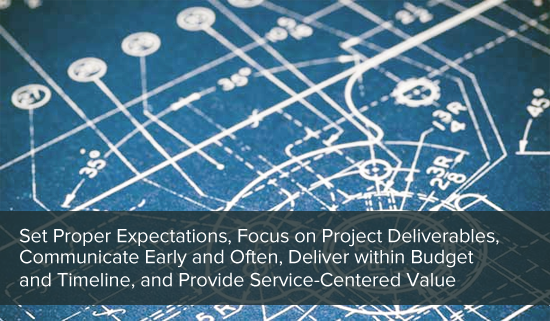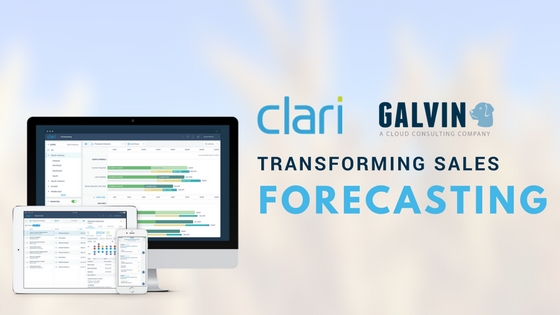What It Means to Go Above and Beyond Client Expectations

There seems to be a common problem in the Information Technology industry: it is a great challenge to deliver a web or software development project on time, on budget, and within scope. According to Advanced Project Portfolio Management and the PMO, only 16% of IT projects are able to achieve this status of official project success. We understand that a project must be managed well from beginning to end in order to go above and beyond a client’s expectations and to achieve this status of project success. In order to do this, we believe that you must set proper expectations, focus on project deliverables, communicate early and often, deliver within budget and timeline, and provide service-centered value.
Set Proper Expectations
Before you dive into any project headfirst, it is important to understand what exactly it is your client needs to achieve. After all, you would not build a house without first knowing how many rooms need to be built, where each room needs to sit, and so forth. A web or software development project is no different; it needs to have a detailed blueprint that outlines the end result at the very beginning. A project should not progress past its Discovery phase without completely understanding the end result and what steps will need to be taken to get there. Once it is determined how you will proceed from Point A to Point B, proper project expectations should be set that meet – but mostly exceed – the client’s needs. Likewise, a proper expectation should be realistic, uncompromising of requirements and deliverables, and courteous of a project’s timeline and budget.
Focus on Project Deliverables
Project expectations and deliverables are equally important and should be your focus of every project. When you focus your attention on the expectations of the project and its end result, it is much easier to understand how you will need to get from Point A to Point B. A project that lacks an end result in sight, however, is unlikely to be successful or survive the unexpected. Not only will focusing on the end result allow you to better understand the overall scope of the project and the tasks at hand, but it will also allow you to effectively manage these tasks and ensure that each one is proactively considerate of project scope and budget.
Communicate Early and Often
Communication is the key to exceeding a client’s expectations and delivering a successful end result. A project that lacks timely and routine communication faces the wrath of the unknown, which can be detrimental to the project’s timeline, budget, and end result. You should strive for consistent communication; this means scheduling a certain time and day every week to follow up with your client to discuss a project. This may include the discussion of the project’s status or any performance, testing, or development issues that may negatively impact the delivery of the project. By setting a specific block of time every week, communication allows you to effectively manage the project to ensure that 1) the project is on time, 2) the project is within budget, and 3) the project will deliver the expected end result.
Deliver within Budget and Timeline
To promote client satisfaction, you should aim to deliver an end result that not only saves his or hers time, but money as well. One way to ensure that a project is not exceeding its budget or timeline is to carefully manage change and unplanned activity. It is often said that in project management, the only constant is change. Therefore it is crucial to plan for these unforeseen circumstances during the discovery phase of the project. Change can be a budget and time killer, because it has the unfortunate potential to interrupt other projects and affect the availability of your resources. It is not an easy task to plan for the unknown, but it is extremely important to establish a budget and timeline that is robust, flexible, and accommodating to unplanned activity. This means determining the complexity of project deliverables, determining the greatest constraints (such as time, resources, et cetera), and then planning for these factors while being considerate of deadlines, budgets, and so forth.
Provide Service-Centered Value
At the heart of it all, a client’s expectations are indefinitely exceeded when you are able to provide service to them that not only satisfies, but surprises. We like to call this “Service Surprise”, which basically means that you strive to provide outstanding service that ends your client’s experience on a shockingly positive note. We want our clients to feel as though we are not only delivering an end result, but an end result that is coupled with service-centered value. Because every client is unique in his or her needs, the expectations we want to exceed will therefore be just as unique. To go above and beyond these needs, it is absolutely necessary to truly know your client and what it is they want to achieve. You should continue to manage the project beyond its delivery date by continuously thinking of ways that can provide more value to the client, such as analyzing the effectiveness of a user interface, revisiting a solution to determine if the workflow has improved processes, or keeping up-to-date with the latest technology threats and compliance standards.
We are able to go above and beyond our client’s expectations by abiding to our process and project management methodologies. Our process and project management methodologies ensure that we set proper expectations, focus on project deliverables, communicate early and often, and deliver within budget and timeline throughout the project’s lifecycle. Likewise, we distribute customer satisfaction surveys post-launch in order to obtain valuable information that allows us to improve service-centered value and our internal processes.
If you are stuck in that 84% that cannot deliver projects successfully or if your current processes or project management methodologies are preventing you from going above and beyond your client’s expectations, it might be the time to take a step back to analyze and restructure your framework to a way that will allow you to do so. We hope that these five tips are able to point you in the right direction to help you deliver your next project that achieves the status of project success.












